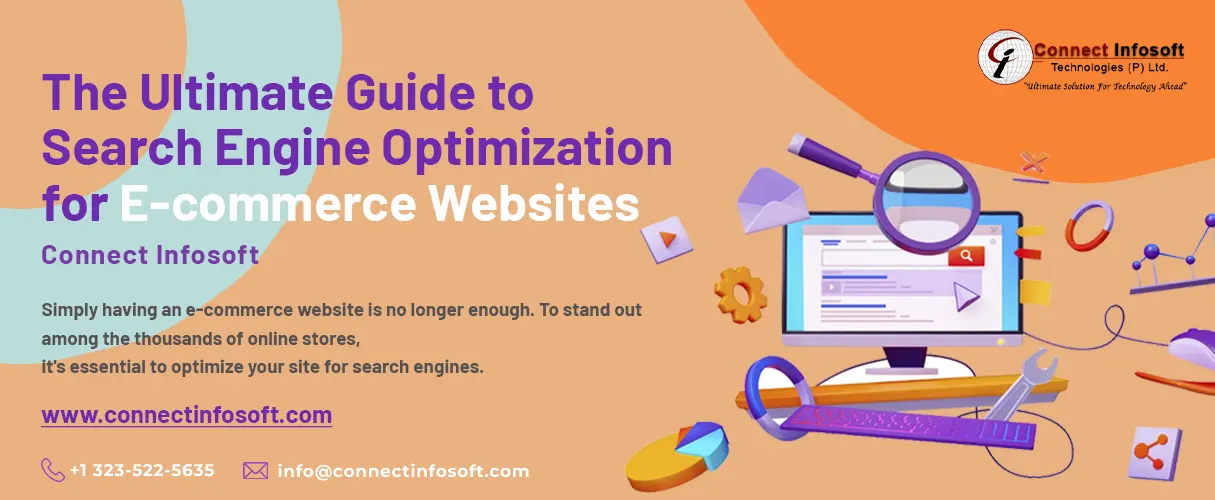The Ultimate Guide to Search Engine Optimization for E-commerce Websites - Connect Infosoft

In today's highly competitive digital landscape, simply having an e-commerce website is no longer enough. To stand out among the thousands of online stores, it's essential to optimize your site for search engines. This process, known as Search Engine Optimization (SEO), can significantly increase your website's visibility, driving more traffic, and ultimately, more sales.
In this comprehensive guide, we'll walk you through the essential strategies and best practices for SEO tailored specifically to e-commerce websites.
1. Understanding the Basics of E-commerce SEO
It's quite important to know what SEO for e-commerce involves before digging into any actual strategies. E-commerce websites have specific needs, as they are built to accommodate a large volume of products, and categories, and also undergo an update frequently. SEO for e-commerce is all about optimizing each of these elements so that they are ranked at the top in the SERPs.
Principal Components of E-commerce SEO
- Keyword Research: Identifying search terms potential customers use to find products.
- On-page Optimization: Ensuring each product page is fully Search Engine Optimized.
- Technical SEO: Working on the backend of your site so that search engines can crawl and index it better.
- Content Marketing: Build content that adds value to be in front of potential customers and continuously keep their interest.
- Link Building: To get high-quality backlinks to your site, increasing its authority and rankings.
2. How to Do Effective Keyword Research
Keyword research is the foundation of any successful SEO campaign. In the case of e-commerce, everything rests on the fact that you will find keywords that do not bring just traffic but that make the browsers turn into customers.
Steps for Keyword Research:
- Use Tools Like Google Keyword Planner or Ahrefs: To find high-traffic and low-competition keywords for your products, you can make use of tools like Google Keyword Planner, Ahrefs, etc.
- Target Long-Tail Keywords: Long-tail keywords are far more specific and hence not that competitive—but relatively easier to rank for.
- Research the Competition: Discover the keywords that your competition is where it holds lofty rankings —Determine whether you should target the same terms.
Example: If you sell organic skincare products, target the wrong main keyword, 'skincare'; however, try to target long-tail keywords like "organic facial cleanser for sensitive skin".
3. On-Page Optimization
What is On-Page SEO?
On-page SEO is the process of optimizing individual pages to rank higher and garner more relevant traffic. It is of utmost importance for product pages in an e-commerce website. Major On-Page SEO Elements of a Product Page.
- Title Tags: Include primary keywords and ensure they’re relevant to the product.
- Meta Descriptions: Write compelling meta descriptions that encourage clicks.
- URL Structure: Keep URLs clean, descriptive, and keyword-rich.
- Header Tags (H1, H2, etc.): Use header tags to organize content and include keywords where appropriate.
- Product Descriptions: Write unique, detailed product descriptions that include relevant keywords.
- Optimize Images: Add alt text to images; compress to ensure better speed
4. Technical SEO: The Backbone for E-commerce Websites
Technical SEO mostly means working on optimizations of the backend of your website. This is greatly important so that search engines can adequately crawl and index the website, with the user experience being more or less convenient.
Best Practices for Technical SEO:
- Mobile Optimization: Your website should be mobile-friendly, as most of the shoppers do shopping using their mobiles.
- Page Speed: Enhance the loading time of your site with proper optimization using tools like Google PageSpeed Insights.
- XML Sitemap: An XML sitemap has to be generated and submitted to the search engine to make it aware of the architecture of the website.
- Robots.txt: Ensure that robots.txt file is not blocking important pages to crawl
- HTTPS: Secure your website with an SSL certificate; it is also a ranking factor;
Example : If your website is slow, customers may just bounce off right before converting. Increasing the speed of your site will drastically bring down the bounce rate and increase conversions.
5. Content Marketing for E-commerce
Content marketing is a technique related to creating and distributing valuable, relevant, and consistent content to attract and retain a targeted audience. For e-commerce, this would mean blogs, buying guides, videos, and many more.
Content Strategies for E-commerce:
- Blogging: Continue writing articles about your products and why they are important to the customers. For example, if it's a clothes store, they could blog about the latest fashion trends.
- Product Guides: How to choose the right product for a customer.
- Video Content: Demonstrating products, how to use a product, and presenting customer reviews.
- User-Generated Content: Encourage customers to give reviews and share photos in the process of using the product.
Example: For instance, a blog where one is selling camping equipment could bear the heading "10 Items You Should Have When Going Camping" to take them to one's website and link with one's products.
6. Build High-Quality Backlinks
Backlinks can be defined as external hyperlinks from other websites leading back to your website. Think of them as scores other websites can give to your website or content, hence a signal to search engines of the validity and relevance of your website.
How to Build Backlinks :
- Influencer Outreach: Get people within your niche who have good influence and let them promote your products or link out to your site.
- Guest Bloggers: Get some guest posting on other relevant authoritative publications in your field.
- Broken Link Building: Find some broken links on other websites and suggest your content as a replacement.
- Press Releases: You can issue press relevant to new products or company news to get backlinks from news sites.
Example: If you have a new product, feature it in an industry blog; the unique backlink will improve your SEO rankings.
7. Local SEO for E-commerce
Local SEO will apply if you are also operating an offline store, other than your online shop. This is the process of enhancing your presence online and is aimed at winning customers within a local region.
Local SEO Tips:
- Google My Business: List your business through Google My Business and consistently update your information.
- Local Keywords: Place location-based keywords in your content and meta tags.
- Local Citations: Consistency of the NAP in all directories
For example, if you manage a local boutique in Chicago, then it would be more worthwhile to enhance the content using the kind of keywords targeted by your local shoppers, such as "Chicago boutique" or "best boutique in Chicago".
8. Measure and Analyze Your SEO Endeavors
It has been said that measuring often and analyzing your SEO operation is ever so important as that the things are done to be sensible or at least to know where the market is moving.
SEO Analysis Tools:
- Google Analytics: Track your traffic, user behavior, and conversion rates.
- Google Search Console: Keeps your results intact and notifies you of any issues.
- SEO tools such as SEMrush or Ahrefs: Can also be used to track your keyword rankings, backlinks, and various other things.
Example: If you notice that a product page is not doing well, then use your analytics tools to identify the loophole—whether page speed, keyword optimization, or user experience.
Conclusion:
SEO can only be an investment in the long term; however, when done right, it starts to rank at the topmost positions of your e-commerce website's visibility, traffic, and sales. In this guide, through the implementation of the strategies, by and large, you will be able to establish an outstanding online presence in this competitive e-commerce landscape.
Connect Infosoft will help you implement the following SEO strategies to ensure your e-commerce website reaches its fullest potential. Get in touch with us now to learn more!


